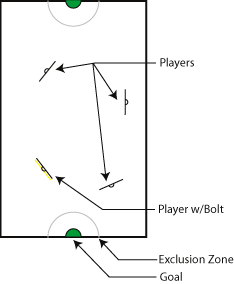Many computer games were developed in the 1960s and 1970s. One of the most famous was Space War, developed for the PDP 1X at MIT and immortalized in an article in Saga Magazine, a men's adventure publication of the era. Space War had many descendants, and you can still find computer games that have the same basic game play, fly around in a space ship and shoot the other guys who are also flying in space ships. One notable variant was Air War for the PDP 4 which had little putt putting airplanes, four shots forward and one shot aft.
Maze Wars dates to the early 1970s and was possibly the first multiple player, first person shooter. You would race around the maze firing at the other players. The graphics were primitive. The game was played in blank hallways, and the weaponry a bit obscure in that firing a shot rarely had an instantaneous effect. Because of the networking delay, it was more like rolling a hand grenade down the hallway than firing a rifle. Maze Wars has many descendants in the gaming world.
Dazzle Darts seems to have vanished into obscurity. It was suggested by a short story called Bullard Reflects by Malcolm Jameson which was published back in 1941 in Astounding Science Fiction. In the story, the game was played on the moon and involved leaping players armed with mirrors to reflect a light beam into a goal. Needless to say the battle of the solar system was won on the leaping and reflecting fields of the moon. Remember, much was made in that era about the fact that one could jump higher on the monand other, smaller planets, than one could on Earth.
 The
computer game was also a team game that involved reflection.
There were
two teams of two players each. The game was played on a
rectangular
field. There was a goal at the center of each of the smaller
ends and a
zone around the goal from which the players were excluded.
Each player
was a mirror and moved perpendicular to the plane (or rather
the line)
of the mirror. In the diagram at the left, I have tried to
capture the
layout of the game. There was a little indicator at the
center of each
player so you could tell forward and backwards.
The
computer game was also a team game that involved reflection.
There were
two teams of two players each. The game was played on a
rectangular
field. There was a goal at the center of each of the smaller
ends and a
zone around the goal from which the players were excluded.
Each player
was a mirror and moved perpendicular to the plane (or rather
the line)
of the mirror. In the diagram at the left, I have tried to
capture the
layout of the game. There was a little indicator at the
center of each
player so you could tell forward and backwards.The controls were simple. Each player could move forward, and possibly backwards. Each could turn quickly clockwise or counter-clockwise. At any given time one player had the bolt (or beam). He could shoot and try for a goal, but the beam had to bounce off of one other player, on either side, before reaching the goal. This may have been one of the first interactive ray tracing systems.
 Alternatively,
the player with the beam could pass it to his team mate.
This worked instantly and was impossible to block. Deception
and
improvisation were important. One common way of getting the
beam past
the defenders was to pretend to line up one shot and then
pass the bolt
to one's team mate, and have your team mate score the goal.
Defense was
further
complicated by the fact that all players were mirrors, so
you had to be
careful not to aid your opponents when you hoped to be
thwarting
them.
Alternatively,
the player with the beam could pass it to his team mate.
This worked instantly and was impossible to block. Deception
and
improvisation were important. One common way of getting the
beam past
the defenders was to pretend to line up one shot and then
pass the bolt
to one's team mate, and have your team mate score the goal.
Defense was
further
complicated by the fact that all players were mirrors, so
you had to be
careful not to aid your opponents when you hoped to be
thwarting
them.If the beam hit the opposing goal, the team got a point and retained the beam. A certain number of points, perhaps eleven determined the game. If the beam missed, the other side was given the beam. The game involved team work and strategy.
The game was very simple in conception and execution, which was very important back then given how slow computers were. Obviously, a much better version of this game could be written today, but Dazzle Darts doesn't seem to have had any descendents.
I have contacted some of the developers involved with the program, but the source code has been lost. By posting this description on the internet, I am hoping that some game developer, lacking inspiration will find some here, and perhaps give Dazzle Darts a new life.

